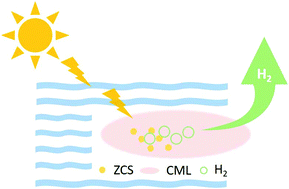A two-dimensional metal–organic framework accelerating visible-light-driven H2 production†
Abstract
The rapid consumption of non-renewable fossil fuels and the relevant critical environmental issues have significantly boosted the demand for clean, renewable and carbon-free energy sources. The conversion of solar energy into green hydrogen (H2) via photocatalytic water splitting stands out as a promising, cost-effective and environmentally friendly technology. However, the realization of large-scale solar-driven photocatalytic H2 production relies on the development of inexpensive, efficient and stable photocatalysts. Here, for the first time, we report the fabrication of Zn0.8Cd0.2S (ZCS) nanoparticles (NPs) dispersed Co-based metal–organic layers (CMLs) using an easy self-assembly approach. The as-synthesized ZCS/CML composite shows a remarkable visible-light-induced H2-production activity of 18 102 μmol h−1 g−1, 492% higher than that of pure ZCS. A series of advanced characterization studies, e.g., synchrotron-based X-ray absorption near edge structure and time-resolved photoluminescence spectroscopy, disclose that the strong electronic interaction between ZCS and CML and the abundant reactive sites on the CML lead to the significantly improved photocatalytic H2-production activity. Our contribution not only demonstrates the application of CML as an earth-abundant support and promoter to tremendously boost photocatalytic H2 production without noble-metal co-catalysts, but also sheds light on the tailored design and synthesis of metal–organic-layer based materials for energy conversion and storage.



 Please wait while we load your content...
Please wait while we load your content...